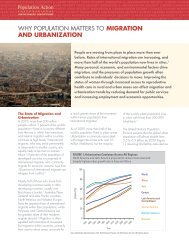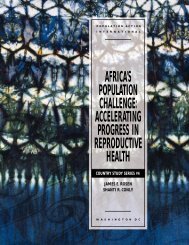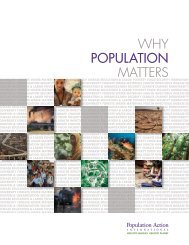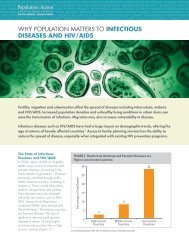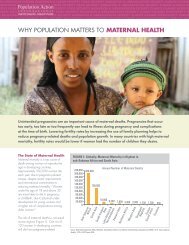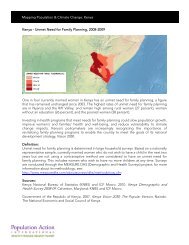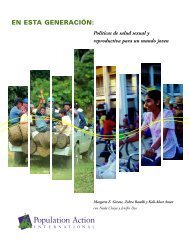Sustaining water, easing scarcity - Population Action International
Sustaining water, easing scarcity - Population Action International
Sustaining water, easing scarcity - Population Action International
Create successful ePaper yourself
Turn your PDF publications into a flip-book with our unique Google optimized e-Paper software.
adequate supplies of renewable fresh <strong>water</strong> could<br />
soon become the main constraint on their economic<br />
development. 12 This is already the case in several<br />
<strong>water</strong> scarce countries in northern and southern<br />
Africa, where population growth rates remain<br />
high, placing incr<strong>easing</strong> pressure on limited <strong>water</strong><br />
resources to meet the growing demand for food<br />
production. In fact, all of the five countries projected<br />
to cross the <strong>water</strong> <strong>scarcity</strong> benchmark within<br />
the next 10 years are in Africa—adding more than<br />
100 million people to those already coping with<br />
severe <strong>water</strong> resource shortages. In these and<br />
many other countries, incr<strong>easing</strong> <strong>water</strong> <strong>scarcity</strong><br />
will cause the cost of producing and delivering<br />
fresh <strong>water</strong> to grow tremendously just to keep<br />
pace with current levels of service. This will drain<br />
financial resources that would otherwise be available<br />
for investment in the development of other<br />
sectors of the economy. 13 With the UN projecting<br />
that more than 90 percent of population growth<br />
Figure 7<br />
WORLD POPULATION IN FRESHWATER SCARCITY, STRESS<br />
AND RELATIVE SUFFICIENCY IN 1995 AND 2050<br />
1995—Total <strong>Population</strong>: 5.7 billion<br />
Medium <strong>Population</strong> Projection<br />
Relative Sufficiency 92%<br />
2050—Total <strong>Population</strong>: 9.4 billion<br />
Medium <strong>Population</strong> Projection<br />
Relative Sufficiency 58%<br />
Stress 24%<br />
Scarcity 18%<br />
3% Scarcity<br />
5%<br />
Stress<br />
Note: The sizes of the pies are proportional to world population in both years.<br />
Chart: <strong>Population</strong> <strong>Action</strong> <strong>International</strong> Data Source: UN <strong>Population</strong> Division<br />
between now and 2050 will occur in developing<br />
countries, 14 the demand placed on fresh<strong>water</strong><br />
resources by these countries will make sustainable<br />
economic development incr<strong>easing</strong>ly difficult. The<br />
examples of regional <strong>water</strong> stress presented here<br />
provide some indication of the seriousness and<br />
extent of the growing competition between nations<br />
for <strong>water</strong> resources.<br />
The Case of Southern Africa<br />
One place where the pressure for renewable <strong>water</strong><br />
resources is beginning to mount is in the southern<br />
region of Africa, where Namibia and neighboring<br />
Botswana are engaged in a dispute over use of the<br />
Okavango River. On the basis of the amount available<br />
per person, Namibia seems to have a relatively<br />
abundant fresh<strong>water</strong> supply. However, Namibia<br />
is the driest country in sub-Saharan Africa—nearly<br />
83 percent of all rain evaporates soon after it falls<br />
and only 1 percent of what remains is available to<br />
recharge ground<strong>water</strong> aquifers. Worse, Namibia<br />
has no perennial rivers, only seasonally flowing<br />
ones that are reduced to a trickle several months of<br />
the year. 15<br />
Traditionally, this was not a problem in many<br />
regions of Namibia, where the mostly rural population<br />
would simply move to other sources of<br />
<strong>water</strong> during the dry season. However, rapid population<br />
growth and more densely populated human<br />
settlements are hampering this migratory lifestyle.<br />
To meet the needs of its growing population,<br />
Namibia has in recent years been forced to<br />
experiment with a variety of <strong>water</strong> supply options,<br />
including desalination and pumping ground<strong>water</strong><br />
from its fossil aquifers. The cost of large-scale<br />
desalination has thus far proved prohibitive, as<br />
Namibia’s major population centers are too far<br />
inland for <strong>water</strong> to be pumped economically from<br />
the coast. The desalination plants that do operate<br />
require enormous amounts of energy, generating<br />
levels of pollution that are excessive relative to the<br />
8



